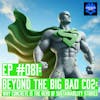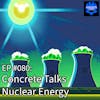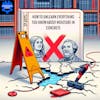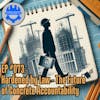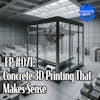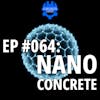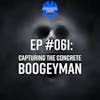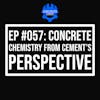EP #049 - Unveiling Concrete Innovators

Curious about the one of the government's driving force behind groundbreaking innovations in the construction industry? Join Seth as he engages in a riveting conversation with Joseph King, an esteemed authority on sustainable construction and energy innovation. Gain exclusive access to the inner workings of the Department of Energy's ARPA-E and explore its audacious mission to revolutionize the way we build.
From unraveling the challenges of enhancing concrete durability to reducing emissions, we dive deep into the cutting-edge materials and technologies fueling this transformation. Don't miss this captivating episode to uncover the untold stories and extraordinary vision of the ARPA-E pioneers. Tune in now to unlock the secrets of sustainable construction innovation!
Episode References Guest: Joseph King | Golden Bear LLC. | josephakingjr@gmail.com Guest Website: https://www.linkedin.com/in/josephakingjr/
Producers: Jodi Tandett, Dr. Jon Belkowitz Become a Producer: https://concretelogicpodcast.com/show-support
Music: Mike Dunton | https://www.mikeduntonmusic.com | mikeduntonmusic@gmail.com | Instagram @Mike_Dunton
Host: Seth Tandett, seth@concretelogicpodcast.com Host Website: concretelogicpodcast.com
EP #049
Seth: [00:00:00] And welcome to another episode of Concrete Logic Podcast, and today I have Joseph King with me. Joseph, you got quite a unique background here. You're currently managing partner at Golden Bear. You're a director at the Department of Energy, and yet you spent some time at DuPont. What else do you want to tell us about yourself, Joe?
Joseph King: I started out actually at GE after I got my PhD and did a postdoc in Germany. Was there for a long time. Spent seven years on in the insurance industry at doing risk management, then got back into science and at DuPont and ran their global construction group for technology.
Seth: Cool. But today we wanna, what's what you're willing to share with us today is your time over at Department of Energy. We thought it might be interesting to talk about when folks apply for grants and different projects out there that maybe. Whatever you can share are the [00:01:00] programs that you were a part of.
So, if you wanna get us started on how that all works. It's I find it interesting.
Joseph King: No, it's not top secret for the Department of Energy. I work for the smallest department within the Department of Energy, but we're often used as reviewers for contracts and grants outside our own department.
I was in the advanced research projects agency for energy. I. And it was modeled after DARPA. How do we do next generation white space in the energy development? And one of my areas especially was cements and concretes. So, I set up a cement and concrete program. Now the way r p e works is you hire, we're short term.
Three years with renewable contracts but usually three years. And then we get a lot of academic people. They have to go back to their institutes after that. If you're an outside person coming from industry, then you have to go out and find a real job again. And the net effect is they like me enough that I stayed [00:02:00] seven years, so I had a lot of fun.
But how it works is, we look for a white space that isn't being addressed in a, any kind of area where there's major greenhouse gas production or energy consumption. And so, for me, that was cementing concretes. And as you may know the embodied energy and greenhouse gas production per kilogram for concrete.
Is among the lowest or is the lowest of any material that man tends to use. So, it's a real challenge. So, my challenge to the community was how do we increase the durability two to three x while lowering the embodied energy in greenhouse gas production. So pretty big challenge. And this is before it got voguish.
This was back in 2015, 2016. It started anyway. We'll put out that challenge. We'll do a request for information. We'll send it out to about 1700 universities and businesses and national labs [00:03:00] to get input on what topics we should look at. Then I'll skinny that down. Hold a workshop and invite. 80 to 90 experts in the area to come who will spend the day and a half quibbling over what are the things that should be funded and what are the things we shouldn't fund.
And then I'll skinny that list down, present an internal presentation in the last two hours to the ARPA E community. And there are only 18 of us at the time. There are only 18 of US program directors, and a program director is a federal employee that controls the funds that go out. To fund the people.
Now after I get approval to do that, it has to go to the Senate. So whatever amount of money I think we're gonna do the Senate has to approve that. But it's a nonobject, which means they have three days to say, yeah, we like it or not. No, we don't like it. So, we're not captive to some of the systems.
The founders of this [00:04:00] Arun Manjur who set this up. Realized that we couldn't be held captive to how Congress works slow. Anyway, so he was a pretty brilliant guy. Anyway, when we do this, we actually usually have what are known as contractual agreements. They aren't grants. We do have grants.
Those tend to be smaller amounts of money, like half a million dollars. And a grant is something that when it's given out, we have no control over the output. Oh. So, academics and people like grants because they can or can't do what they claim they were gonna do.
Seth: Okay. They get to play more
Joseph King: then Yeah.
They have a lot more latitude to do it. So, when in a contractual agreement, if you're not following, What we negotiated you're gonna deliver and we'll put in some go no-go points throughout it. They're usually three year contracts. Then we can cancel [00:05:00] your project in 30 to 60 days. Oh wow.
Completely. And then I'll take, because the money is already predefined in by the Senate and approved by the Senate. We can't add new members, but we can reallocate that money. Among the remaining members, so we can actually, it's called a plus up. We can actually give them more money. Oh. So
Seth: is there checkpoints for them when you do a grant, do you say there, you have this deliverable by this date, and if you don't get any more money, like building a house?
We're,
Joseph King: we're more. Engaged than that. Oh, okay. Okay. We want all of our children to grow up and be successful, right? Yep. So, we do quarterly reviews, usually face to face, particularly when we're starting out, and that really helps a, with the discussion, the teams like it a lot better. They get to know you.
But it causes a lot of travel for the directors. And so, the pro principal investigator [00:06:00] and the program director are the only ones that are technically supposed to meet face-to-face. But if I'm going to say UCLA or MIT, the whole team will probably be at MIT. Okay. And I'll have one or two technical support people that work with me too.
Now, one of the things that happened early on is they realized that some of their programs started out as two guys in a garage, and at the end of three years it was still two guys in the garage. So, they added something called the tech to market group into ARPE. And this was a couple years after it started.
And RPE is one of the newest organizations. It's only about 14, 15 years
Seth: old. Yeah. And if we didn't say it, RPE is Advanced Research Projects Agency. I said
Joseph King: that once, but oh, sorry. But I didn't tell him that. That's the acronym. Okay. I apologize for that. Yeah. Anyway, And what they do is they help the team structure a business program.
We don't fund [00:07:00] science for the sake of science. NSF does that, sometimes NIH does that, but we want something that is scalable, buildable commercializable. And if. You're not gonna use it. It should be sociable among the community too, because we're picking the best brains from the entire community to solve these problems.
And if we're gonna fund your project to do one of those, then we want there to be a benefit for the community. These are American taxpayer dollars that we're throwing around. So yeah, we wanna make sure there's something coming out of that so that. Commercial liability and scalability is a huge part of how we make our assessments now.
We'll come every quarter. My first year I think I did a little over 150,000 miles flying domestically. Whoa. Not counting all the driving, but you get to know the teams, you can see what's working and what isn't, and you can help [00:08:00] them with getting contacts. And if they don't know how to do something or they're great chemical engineers, but they haven't done any of the marketing stuff, the marketing guys will help them figure out how to build Abu Business Plan and put that together.
How to do a cost benefits analysis, how to do a technical economic analysis of the cost. First where you are versus at scale. If you can scale it and get connected to groups that might be able to help them, think about how to run a business. Huh? So, there's a lot of value we bring. We're a little scary because we are feds uh huh, and, here we're the government, we're here to help.
There's a scary phrase, but that's not how RPE works. Our goal is to make you successful. But if there's some. Physical reason, some physics, engineering thermodynamic reason that was not apparent at the beginning of the project. So, it can't be done. We'll try to work [00:09:00] with you to pivot it into something successful.
And if that can't be done, then we'll have to cancel it. And we tell them all that upfront when we do our negotiations. We. We work out a timeline, we work out a stage deliverable for each of those timelines, and one of those stage deliverables would be a go no go point. So, if they can't hit that, then you know, game over right.
So it's important, but the other thing we look for in the teams is it a balanced team? It's one, one thing to have an idea that you can reduce the practice on a bench, but can you scale and execute it? Have you thought through that? Are there members of the team so that it's not just, two great material scientists coming up with the next generation cement?
Can they actually, do they understand the fabrication, the scale, the production of it? And how would you commercialize it All? All those stages have to be [00:10:00] built in every single program or we don't fund you. Even if
Seth: it's a great idea. Yeah. Again, I have a business plan.
Joseph King: And it's amazing how many professors are really good about thinking of ideas, but not so good on the business plan execution side.
Yeah.
Seth: They're academics. They haven't worked out in the, commercial, private world, so they haven't ran a business before. I assume, but they're good at thinking though.
Joseph King: Yeah, but that's not enough in our book. That's more NSF than it is us. Yeah. And NSF brings a lot of value because some of those are prelude to us.
And some of our programs, for example we actually do stuff in the nuclear area. We have a three or four excellent fission fusion people. And those then sometimes go into the nuclear part of the Department of Energy as a follow on. So, some of the advanced manufacturing organization, which is also in the Department of Energy, they will sometimes take, [00:11:00] pick up some of our stuff too.
It's, we're trying to get him past the Valley of death, but we are, we fund all sizes of groups. A third large corporation, a third academic, and a third national lab in small business and startups. So if you, that's how our money gets allocated. Not by design, but by fact. If GE comes to me with a great idea and has a great proposal, we'll fund GE.
If you know a small startup, that's a spin out of VCU, VCU, and it's a great idea. And they have the team put together. We fund them. So
Seth: it's like Silicon Valley of the government.
Joseph King: Yeah. We try to be, and for all the different areas, like I said, we span everything from marine crop production to nuclear to.
To cement and concrete. Of course I do have to mention that since this is a concrete show we try to be, at least[00:12:00] when I was creating the durable concrete program my boss came to me and said, Joe, how do I know your advanced gray of cement is? Different than the old gray lump and cement.
And I said if they use it and it is more durable, does that pothole show up every three years instead of every year? There are durability things, and I think this is where transportation plays a big. A big role because building a bridge ticking or a highway component, the abuse that it sees per unit time is great enough that that for me was the regime that I like to see for advanced accelerated testing.
People talk about lab stuff. No, I wanted doubt in the real world. Yeah.
Seth: Did yeah it's refreshing to hear that there's Agencies and the government out there that think long term instead of short term, if you know if. This program sound sounds like you're concentrating on the durability of concrete.
[00:13:00] So we didn't have to go out there and replace it and repair it year after year. Cuz when I hear the government, I hear we need to spend more money. We're just, we just raised the debt ceiling again. We're always looking to spend more money. So it's refreshing that you we're, there are parts of the government that are looking to refrain from that.
Joseph King: If you're familiar with the business world, you realize that the people building it. And the people that have the o and m or operation and management and repair side of it are not the same. So if you put up a structure and say it's day one cost is a million dollars the operation and management over that 30, 50 year lifetime.
There's gonna be six to 10 x of that in terms of repair and what you do. So you want to mitigate both sides. I want to mitigate the greenhouse gas and embodied energy, but I want to improve the durability simultaneously. So the actual owner benefits from what they invest in. Huh.
And [00:14:00] your specialty was in concrete and cement when you were there?
It was material. So I did that and I also did grid space. Okay. And my first, what happens is because the program director's timeout, Sometimes there'll be a residual program, and I inherited one for natural gas. Oh, cool. And it was called Monitor. And if you go to the RPE site in the Department of Energy, you can see all of our programs and who's assigned to them.
And what it was is you, how do you detect, locate, and quantify natural gas leaks. And that was the intent of that. One of the things I did learn, and this is how I, our preload discussion about leaking gas wells. I spent a lot of time with the drillers and guys that changed the casings and all that kind of stuff.
So I got a pretty good view of. How difficult it is for the gas industry to manage particularly orphan and abandoned wells and those end [00:15:00] up being problems in the state or the federal government. Just because until the 1950s, they didn't even track. Orphaned and abandoned wells. And then a lot of them post that have been cut down, what they say, cut below the plow line so that people could use the fields again.
So they might not even know there are abandoned wells underneath their field. That's not good. No. It's a surprise depending on where he, but ha what happens. But yeah.
Seth: Huh. So can you talk a little bit about the, maybe some of the projects you ran across or were fans of?
Joseph King: Yeah. One of the ones that I since rebar is one of the main or the main degradation method mode for a lot of structures.
And you see it's degradation. It basically expands a factor three and crushes the cement from the inside or concrete from the inside. I invested in a group in the upper peninsula that made Basaltic rebar [00:16:00] and Owens Corning actually started out making basaltic materials but they found that sand was more consistent than basalts, the natural rocks.
And I think when you were talking to the Alamo guy, he mentioned about how he. His limestone might be different than North Carolina limestone different than Montana's limestone. And he's absolutely right. And so the inconsistency in the basalts, you need certain qualities of it and this one group Navos had come across that and.
Done a great job, but they needed to fix the bushing on their strand. The bushing is the plate that has all the little holes that things strand through. And where did the basalts come from? Basalt is an igneous rock that's basically the majority rock on Earth's crust. Oh, okay. So it's there's lots of it then There is a lot of it.
And it's very cheap. Yeah. And you can see it everywhere. Like the Devil's Tower in Wyoming. Yeah, that's is a basalt. [00:17:00] Yeah. Or the Giants causeway, and then you get these giant hexagonal pillars that are just. The way it cools so you see that, you can see some of those in the United States is the Columbia Gorge is basically the salt wall.
So you can find it everywhere or you can mine it. And so he was doing that. He also makes egl glass strands too. And the reason we funded that is I was hoping that he could get around the degradation problems that you have when you carbonate over time the rebar. And it degrades.
And he's still developing that and, but he was working a little bit. Owen's Corning kept coming to them, and now Owen's Corning comes out with their pink bar. And it's basically getting away from steel rebar and some of the MI problems that you have with that. Plus it's got a huge weight advantage and it's compatible with the cement environment.
Seth: What are the limitations of it though compared to steel? Are there, if there are any?
Joseph King: [00:18:00] I haven't followed that as much because there's not enough of it out in the field to say, oh, this bridge structure fell down because they used it. Or This highway wasn't expansive enough. It tends to be slightly more ductal and flex.
You can flex it a lot more and some of those problems. Could degrade it over time depending on how brittle the material is around it. But I don't think there's enough long-term data on a statistically large enough sample set to, to say at this point. Everything looks good now. Yeah. But we need more data to say, and I think a lot of the demonstration projects that are going on right now some are 10 years old, but that's still in its infancy if it's a cement concrete structure.
Seth: Yeah, exactly. Yeah. That's the intent at least.
Joseph King: Yeah. No, the intent is, is there an alternative to steel? Even steel production is a huge greenhouse gas producer. [00:19:00] And Not that you don't use a lot of energy to make glass fiber, but the glass rebar might also mitigate our demand for steel as well.
So that would be quite an advantage of it if it can be generally used. Yeah.
Not to put you off track here, but you mentioned something that caught my ear was the use of energy, more energy using Like you were saying, steel uses a lot of energy to produce. Are, is the intent, since you've worked for d o e, is the intent to, for us to use less energy to offset the greenhouse gas gases?
Or are we looking at different ways to maybe I don't know, lack of better words, filter that stuff out so it doesn't get out in the atmosphere and impact
us? It's a combination of things because the energy footprint. Of a material is a compilation of things. And if you do an accurate life cycle assessment for say concrete, it really starts [00:20:00] at the mine because you gotta mine it, you gotta transport it, you gotta grind it.
You, you gotta send it through the kiln. And then, you got clinker, you gotta grind it again. Yeah. And blend it. And then you gotta bag it and then it's gotta go to wherever it's gotta go. So you know, the energy, even for the transportation and the mining is part of the legacy energy footprint.
So can you. Shorten or eliminate some of those things. And so it's not just greenhouse gas production, 60%, roughly 60% of the gas CO2 comes from the actual kiln, the first stage of the kiln. When you take limestone and it makes lime. CO2 coming off. Yep. But then about 17% of the energy is from the fuel that burns and heats the first section of the kiln, and then about another 17% that does the second stage where you're making the A light, B light and the other components that ultimately coagulate [00:21:00] into a clinker.
Can you mitigate some of that footprint? And so a lot of the people focus on the CO2 production from limestone. So they come up with, one L and lc three and some of these other things that use clays. You don't get around the fuel component other than you lose the second part of the kiln 17% for the fuel in the CO2 production from the limestone.
Okay. But it's still a 50 mix. Lc three is still a 50% mix. Of O P C itself. And one L is a 90% mix of O P C, so there's still a lot there, but less. So the question comes back then, does it have the durability and the performance characteristics that the people need in the field?
And lc three has been around for quite a while. Two decades, mainly in Europe. But one l I think It's worked its way in here and there, but it still scares people from what I can tell.
Seth: Yeah, we just, it's a new thing that we're all [00:22:00] getting used to, but we've said it before on the podcast that we've gone through SCM’s and things in the past that we weren't used to and somehow got past that and that was that maybe 2010, 11, 12, was when those really came on.
But we finally got used to that and now the cement industry decided to change things up on us again. So we're all, we don't know what to do. I, and it's Again, like you mentioned before previous guests really depends where you are in the country and things like that. It performs differently versus, in a cold environment versus a warm environment and things like that.
That these are things we're all learning. And then on top of that, it seems there's a big influx of new ad mixtures too. And so we're throwing that in the mix. So on top of just trying to figure out a plane, Just regular concrete with the new cement in it. We're throwing chemicals and all kinds of new stuff in it, and some guys are finding [00:23:00] success and others are just chasing their tail trying to figure it out because bottom line is when we put the concrete down, we want nice quality finish and we don't wanna be standing there for two days as it cures either.
So that's
Joseph King: That's spoken as the guy installing it as opposed to the guy owning it. That's right.
Seth: So that's what we're going through right now. But
Joseph King: And that's, but it's been known for a substantial amount of time that the lower or the more mitigated and metered out the heat of evolution and time to set and keeping it well hydrated.
Gives you a much more durable structure, right? Because you get away from the micro cracking that happens from the high thermal excursion. And so that's been known for a long time, but day one, drivability that some people want it's diametrically opposed to durability and, and I think most people don't realize how.[00:24:00]
How important it is to mitigate as much micro cracking in the early stages of cement, because that's your prelude to bigger cracks later on. Yeah, and so I feel the pain on both sides. The side doing the installation, they're following rules, they wanna finish the project and move on. But I also side a little bit more with the owners that have to maintain the structures because.
Once it's a freeway or an overpass or a bridge goes into operation, people's lives are now engaged.
Seth: Yeah. Yeah. Push back a little bit. So DOT and those folks. I understand that And you, you could probably I don't know their maintenance program, but I know just through my career building different things parking garages mainly That owners don't maintain their product and they want it done fast.
They want, they, they don't wanna wait around. They want to hear any [00:25:00] excuses why things take longer to build. Cuz we're using the new cement. They don't, they can't charge until it's there. That's right. And the concrete guy makes money the quicker he puts it down. And. But to go to your point about the quality of it and doing the curing is what you're inferring to the right way.
Hopefully you do it right the first time. You don't have to go back. Cuz we do a lot of that too. We put it down and then we go back and fix things, which we're really good at that.
Joseph King: The building industry is plagued by callbacks and that's where you lose all your money. Yeah. So you don't wanna have a callbacks, but sometimes.
To your point, it takes too long to do it to the nth degree.
If everyone's on the same page and understands that, that, hey, this is the new process, this is how it's, yeah. Then, yeah. If everybody's on board that say, Hey, instead of, for instance, if you're doing a multi-level post-tensioning deck and we like to pull PT the next day if everyone understands now that now maybe it's three [00:26:00] days, maybe it's seven days before you get on there, pull pt and the concrete's going to perform better than doing in that fashion.
Yeah, but those are agreements you need up front because I don't think it's malicious intent that people want to finish things quickly. I think it's a highly desirable component in how we live, but sometimes I don't think people appreciate the downside of doing that sometimes. And just because something didn't fall apart in the first 10 or 15 years.
If it's supposed to last 70 years. Yeah.
Seth: Yeah. Like our infrastructure issues that we're having right now. Yeah.
Joseph King: We got a 1950s, 1960s infrastructure, and we want everything to work perfectly. We got 1700 dams that need for replacement or our restoration. We got 42% of all of our bridges in the United States are past their useful lifetime or the [00:27:00] estimated lifetime when they're built.
And the American civil Engineering Association puts out a report card every couple years and we're at a d plus for infrastructure. And their estimate back in 2017 was that we need 3.5 trillion just to do all the maintenance on our buildings. And 10.3.
By 2040. And when you look at that and Congress patting themselves in the back for passing a 1.2, there's a disconnect about how expensive it is to replace, structures. Yeah. That are critical. Yeah. And then we're surprised when things fall down and I don't think the concrete and engineering groups are, but I think everybody else is.
Yeah. Yeah.
Seth: Is there any other programs or anything else with the DOE you wanna share with us today?
Joseph King: Oh, the other one that you might look into that [00:28:00] does a bigger is ERE. That's the Energy Efficiency and Renewable Energy. They're a much larger group too, and they have a number of programs that they come up with.
Related to cements and concretes and their funding is RPE tends to be in the 1.8 to about 5 million on an average for funding individual projects. And E R E can be substantially more than that. We do have something called scale up for projects we've funded in the past, and those can be as high as 10 or 15 million.
But you have to have gone through the original funding proposition through RPE before you can qualify for that. But Department of Transportation is getting heavy into cements and concrete studies right now too. Yeah. So I would track their site as a potential area. And of course they're doing large structures and so they must fund prototype [00:29:00] projects that are probably north of 10 million,
Seth: yeah, other than the CO2 puzzle that we're trying to figure is there any other. Like we were talking before, any other challenges out there that the DOE has put out that comes to mind?
Joseph King: Besides the, what I called cement program. There's another one using waste, waste energy and waste materials as sems too.
That's an a colleague of mine, Doug Wicks put that together and a lot of the big waste management groups or Browns Ferry and all these really want to figure out a way, cuz waste materials just keep accumulating. You can't keep land filling them, so can you valorize them some way and burning them for their energy content and then taking the ash and using that as a value added material is one of the ways they're looking at it.
They're also looking [00:30:00] at it as a way of concentrating critical elements for a lot of the other components that people use in electronics, magnets and things like that.
Seth: Yeah. I just read something and I shared on a newsletter I sent out to my subscribers about the amount of tires we produce every year and the amount that go in the landfill and the That we burn as well.
The amount of that is just mind boggling. Like you could literally stack the tires on top of each other and go to the moon. The amount of tires that are out there
Joseph King: You might remember that Jock Cousteau wanted to build islands out of used tires.
Seth: I don't recall that. Yeah. Did he really?
Joseph King: He wanted to build reefs and tires because they're, Among the most durable things on the planet.
Seth: Yeah. They last, it takes, what, 50 plus years for them to degrade.
Joseph King: Even then there's still something left. It's they're a very tough crosslink, polymeric system. They're black because you put carbon black in it, [00:31:00] but they're hard to recycle because there's this dog's dinner of chemicals plus, steel belts and.
Nylon threads and it's, you can't disaggregating and just grinding them up. Sometimes people use 'em in as FTIC applications. So in asphalts. Yep.
But
Seth: that's where they chew 'em up and then, you see 'em at the playground as Yeah. As the ground. So, the kids bounce off the ground when they fall down.
Joseph King: Yeah. Unlike us, we just hit the hard concrete.
Seth: Yeah. So, what what's occupying most of your time now since you're not at the DOE?
Joseph King: Since I started in Golden Bear a number of groups have used me as a consultant on cements and concretes. But they also wanna make sea barriers as an it's one of these things.
I was on the Department of Defense's view Committees for Defense, which is making reefs to stabilize offshore and whether or not you believe in global warming, Erosion is as huge a problem [00:32:00] as the rising seas. So can you do these barrier things to help mitigate the impact of storms on both the stability of the land and protection of people And so I'm looking into marine concretes a lot right now.
So yeah, it has, A secondary thing is it has to be biocompatible with the environment. You can't just have it there. You want little sea creatures to embed themselves on it. And make it a natural material after. Yeah. So, you become the base and then the accretion from all little creatures become the big barrier over time, and then it's alive.
Seth: So, what's the status of that project? Are you guys still thinking of what that recipe looks like or?
Joseph King: The Department of Defense has already moved on and is doing a lot of testing protocols out there. I'm not engaged in that beyond. Okay. So, I don't know the state of those projects other than they should be more than a year [00:33:00] into it now.
The one that I'm doing up off Long Island is just getting started. Okay. So, ask me in a year, how's it going?
Seth: We'll get you back on the podcast and talk about it. Joe, I think there's a good spot to stop today. If folks wanna reach out to you, what's the best way?
Joseph King: The easiest way is probably an email and it's just my name, Joseph akingjr@gmail.com. So, it's j-o-s-e-p-h-a-k-i-n-g-J-R@gmail.com.
Seth: Cool. Yep. And we'll put that in the show notes so everyone can reach out to Joe. Joe, I appreciate you coming on the podcast. Thank you. And just to share, this is my first live in the studio podcast with legit gear. So, Joe, thanks for coming.
Joseph King: Thank you very much for inviting me. All right.









